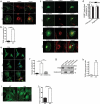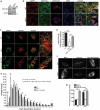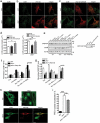Cross-regulation of defective endolysosome trafficking and enhanced autophagy through TFEB in UNC13D deficiency
- PMID: 30892133
- PMCID: PMC6735675
- DOI: 10.1080/15548627.2019.1596475
Cross-regulation of defective endolysosome trafficking and enhanced autophagy through TFEB in UNC13D deficiency
Abstract
Several lines of evidence support the occurrence of cross-regulation between the endocytic pathway and autophagy, but the molecular mechanisms regulating this process are not well-understood. Here, we show that the calcium sensor UNC13D regulates the molecular mechanism of late endosomal trafficking and endosomal maturation, and defects in UNC13D lead to macroautophagy upregulation. unc13d-null cells showed impaired endosomal trafficking and defective endocytic flux. The defective phenotypes were rescued by the expression of UNC13D but not by its STX7-binding-deficient mutant. This defective endosomal function in UNC13D-deficient cells resulted in increased autophagic flux, increased long-lived protein degradation, decreased SQSTM1/p62 protein levels and increased autolysosome formation as determined by biochemical, microscopy and structural methods. The autophagic phenotype was not associated with increased recruitment of the UNC13D-binding proteins and autophagy regulators, RAB11 or VAMP8, but was caused, at least in part, by TFEB-mediated upregulation of a subset of autophagic and lysosomal genes, including Atg9b. Downregulation of TFEB decreased Atg9b levels and decreased macroautophagy in unc13d-null cells. UNC13D upregulation corrected the defects in endolysosomal trafficking and decreased the number of accumulated autophagosomes in a cellular model of the lysosomal-storage disorder cystinosis, under both fed and starvation conditions, identifying UNC13D as an important new regulatory molecule of autophagy regulation in cells with lysosomal disorders. Abbreviations ACTB: actin, beta; CTSB: cathepsin B; EEA1: early endosome antigen 1; ESCRT: endosomal sorting complex required for transport; FHL3: familial hemophagocytic; lymphohistiocytosis type 3; HEX: hexosaminidase; HLH: hemophagocytic lymphohistiocytosis; LSD: lysosomal storage disorder; MEF: mouse embryonic fibroblast; SEM: standard errors of the mean; SNARE: soluble n-ethylmaleimide-sensitive-factor attachment receptor; STX: syntaxin; SYT7: synaptotagmin VII; TFE3: transcription factor E3; TFEB: transcription factor EB; TIRF: total internal reflection fluorescence ULK1: unc-51 like kinase 1; UNC13D: unc-13 homolog d; VAMP: vesicle-associate membrane protein; WT: wild-type.
Keywords: Autophagy; FHL3; TFEB; endosomal trafficking; fusion; lysosomal signaling; secretion.
Figures








Similar articles
-
TFEB-driven endocytosis coordinates MTORC1 signaling and autophagy.Autophagy. 2019 Jan;15(1):151-164. doi: 10.1080/15548627.2018.1511504. Epub 2018 Sep 10. Autophagy. 2019. PMID: 30145926 Free PMC article.
-
Impaired TFEB-mediated lysosomal biogenesis promotes the development of pancreatitis in mice and is associated with human pancreatitis.Autophagy. 2019 Nov;15(11):1954-1969. doi: 10.1080/15548627.2019.1596486. Epub 2019 Mar 30. Autophagy. 2019. PMID: 30894069 Free PMC article.
-
Trehalose induces autophagy via lysosomal-mediated TFEB activation in models of motoneuron degeneration.Autophagy. 2019 Apr;15(4):631-651. doi: 10.1080/15548627.2018.1535292. Epub 2018 Nov 5. Autophagy. 2019. PMID: 30335591 Free PMC article.
-
Transcription factor EB: from master coordinator of lysosomal pathways to candidate therapeutic target in degenerative storage diseases.Ann N Y Acad Sci. 2016 May;1371(1):3-14. doi: 10.1111/nyas.13131. Ann N Y Acad Sci. 2016. PMID: 27299292 Free PMC article. Review.
-
The Lysosome and Intracellular Signalling.Prog Mol Subcell Biol. 2018;57:151-180. doi: 10.1007/978-3-319-96704-2_6. Prog Mol Subcell Biol. 2018. PMID: 30097775 Review.
Cited by
-
Nuclear miR-30b-5p suppresses TFEB-mediated lysosomal biogenesis and autophagy.Cell Death Differ. 2021 Jan;28(1):320-336. doi: 10.1038/s41418-020-0602-4. Epub 2020 Aug 6. Cell Death Differ. 2021. PMID: 32764647 Free PMC article.
-
Alternative UNC13D Promoter Encodes a Functional Munc13-4 Isoform Predominantly Expressed in Lymphocytes and Platelets.Front Immunol. 2020 Jun 9;11:1154. doi: 10.3389/fimmu.2020.01154. eCollection 2020. Front Immunol. 2020. PMID: 32582217 Free PMC article.
-
UNC13B regulates the sensitivity of Wilms' tumor cells to doxorubicin by modulating lysosomes.Oncol Lett. 2024 Jul 22;28(3):446. doi: 10.3892/ol.2024.14579. eCollection 2024 Sep. Oncol Lett. 2024. PMID: 39091580 Free PMC article.
-
Randomized phase II clinical trial and biomarker analysis of paclitaxel plus epirubicin versus vinorelbine plus epirubicin as neoadjuvant chemotherapy in locally advanced HER2-negative breast cancer with TEKT4 variations.Breast Cancer Res Treat. 2021 Jan;185(2):371-380. doi: 10.1007/s10549-020-05940-8. Epub 2020 Sep 25. Breast Cancer Res Treat. 2021. PMID: 32975708 Clinical Trial.
-
A dominant negative variant of RAB5B disrupts maturation of surfactant protein B and surfactant protein C.Proc Natl Acad Sci U S A. 2022 Feb 8;119(6):e2105228119. doi: 10.1073/pnas.2105228119. Proc Natl Acad Sci U S A. 2022. PMID: 35121658 Free PMC article.
References
Publication types
MeSH terms
Substances
Grants and funding
LinkOut - more resources
Full Text Sources
Other Literature Sources
Molecular Biology Databases
Research Materials
Miscellaneous
